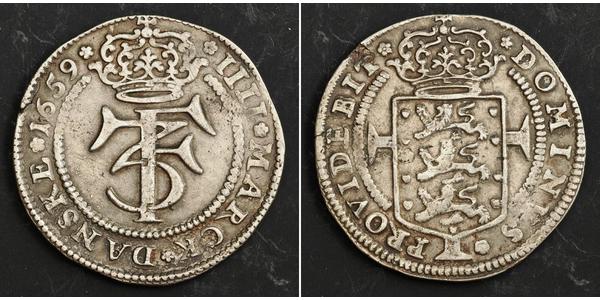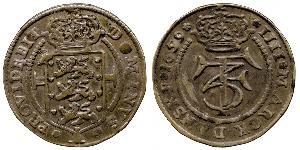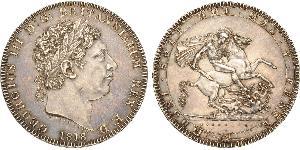1 Крона / 4 Марка (продана за $158.0)
1659, Kindom of Denmark, Frederik III. Silver 4 Mark (Krone) Coin. XF+
Mint Year: 1659 Mint Place: Copenhagen Denomination: 4 Mark (1 Krone) Reference: Davenport 3574, KM-194.4a ($525 in VF!) Condition: Light rusty deposits, minor mint-made planchet imperfections, a few contact-marks and scratches, otherwise a nice XF+ Weight: 21.74gm Diameter: 41mm Material: Silver
Obverse: Crown above cipher of Frederick III (ligate F3) within inner circle. Legend: * IIII * MARCK * DANSKE * 1659 * Reverse:Crowned shield of the Kingdom of Denmark, on short-cross with triangle-shaped ends. Legend: * DOMINVS * PROVIDEBIT * ("The Lord will provide!")
Frederick III (Danish: Frederik III; March 18, 1609 – February 9, 1670) was king of Denmark and Norway from 1648 until his death. He instituted absolute monarchy in Denmark and Norway in 1660, confirmed by law in 1665 as the first in western historiography. He was born the second-eldest son of Christian IV of Denmark and Anne Catherine of Brandenburg. Frederick was only considered an heir to the throne after the death of his older brother Prince Christian in 1647. At the death of Christian IV of Denmark, Frederick conceded significant influence to the nobility in order to be elected king. As king, he fought two wars against Sweden. He was defeated in the 1657–1658 Dano-Swedish War, but attained great popularity when he weathered the 1659 Assault on Copenhagen and won the 1658–1660 Dano-Swedish War. Later that year, Frederick used his popularity to disband the elective monarchy in favour of absolute monarchy, which lasted until 1848. He married Sophie Amalie of Brunswick-Lüneburg, with whom he fathered Christian V of Denmark.
Frederick was born at Haderslev in Slesvig, the son of Christian IV of Denmark and Anne Catherine of Brandenburg. In his youth and early manhood, there was no prospect of his ascending the Danish throne, as his older brother Christian was elected heir apparent in 1608. Frederick was educated at Sorø Academy and studied in the Netherlands and France. As a young man, he demonstrated an interest in theology, natural sciences, and Scandinavian history. He was a reserved and enigmatic prince who seldom laughed, spoke little, and wrote less, a striking contrast to Christian IV. But if he lacked the impulsive and jovial qualities of his father, Frederick possessed the compensating virtues of moderation and self-control. On 1 October 1643 Frederick wed Sophie Amalie of Brunswick-Lüneburg, the daughter of George, Duke of Brunswick-Lüneburg, who had an energetic, passionate, and ambitious character. He was an enthusiastic collector of books and his collection became the foundation for the Copenhagen Royal Library.
In his youth, Frederick became the instrument of his father's political schemes in the Holy Roman Empire. He was granted administration of the Prince-Archbishopric of Bremen (1635–45), the Prince-Bishopric of Verden (1623–29 and again 1634–44), and named coadjutor of the Bishopric of Halberstadt. At the age of eighteen, he was the chief commandant of the Bremian fortress of Stade. Thus, from an early age, he had considerable experience as an administrator, while his general education was very careful and thorough. During the Torstenson War of 1643–45, Frederick lost control of his possessions within the empire. He was then appointed commander in the Schleswig-Holstein duchies by his father. His command was not successful, chiefly owing to his quarrels with the Earl-Marshal Anders Bille, who commanded the Danish forces. This was Frederick's first collision with the Danish nobility, who ever afterwards regarded him with extreme distrust.
The death of his elder brother Christian in June 1647 opened the possibility for Frederick to be elected heir apparent to the Danish throne. However, this issue was still unsettled when Christian IV died on 28 February 1648. After long deliberation among the Danish Estates and in the Rigsraadet royal council, he was finally accepted as king Frederick III of Denmark. On 6 July, Frederick received the homage of his subjects, and he was crowned on 23 November. However, due to misgivings about the rule of Christian IV, as well as Frederick's previous confrontational administrations in Bremen and Verden and his quarrels with Anders Bille, he was only elected after he had signed a Haandfæstning charter. The Haandfæstning included provisions curtailing the already diminished royal prerogative in favour of Rigsraadet receiving increased influence.
In the first years of his reign, Rigsraadet was the main power center of Danish politics. However, Frederick wielded more power than what was instituted by the Haandfæstning and eventually succeeded in removing the two most influential members of Rigsraadet from office in 1651: his brothers-in-law Corfitz Ulfeldt and Hannibal Sehested. Ulfeldt went into exile in Sweden where he turned traitor, while Sehested was restored to favour in 1660.
With all his good qualities, Frederick was not a man to recognize fully his own limitations and that of his country. But he rightly regarded the accession of Charles X of Sweden on 6 June 1654 as a source of danger to Denmark. He felt that temperament and policy would combine to make Charles an aggressive warrior-king: the only uncertainty was in which direction he would turn his arms first. Charles's invasion of Poland in July of 1655 came as a distinct relief to Frederick, though even the Polish War was full of latent peril to Denmark. Frederick was resolved upon a rupture with Sweden at the first convenient opportunity. When Rigsdagen assembled on 23 February 1657, it willingly granted considerable subsidies for mobilization and other military expenses. On 23 April he received the assent of the majority of Rigsraadet to attack Sweden's German dominions. In the beginning of May, the still pending negotiations with that power were broken off, and on 1 June Frederick signed the manifesto justifying a war, which was never formally declared.
The Swedish king confounded all the plans of his enemies with the March across the Belts in January and February 1658. The effect of this unheard-of achievement of crossing the frozen sea to invade Danish territory was crushing. Frederick at once sued for peace. Yielding to the persuasions of the English and French ministers, Charles finally agreed to be content with mutilating, instead of annihilating, the Danish monarchy. The Treaty of Taastrup was signed on February 18 and the Treaty of Roskilde on 26 February 1658. The conclusion of peace was followed by a remarkable episode. Frederick expressed the desire to make the personal acquaintance of his conqueror and Charles X consented to be his guest for three days, 3 March to 5 March, at Frederiksborg Palace. Splendid banquets lasting far into the night and intimate conversations between princes who had only just emerged from a mortal struggle seemed to point to nothing but peace and friendship in the future.
But Charles's insatiable lust for conquest and his ineradicable suspicion of Denmark induced him to endeavour to despatch an inconvenient neighbour without any reasonable cause or declaration of war in defiance of all international standards of acceptable behavior on the part of rulers. Terror was the first feeling produced at Copenhagen by the landing of the main Swedish army at Korsør on Zealand on 17 July 1658. None had anticipated the possibility of such a sudden and brutal attack, and everyone knew that the Danish capital was very inadequately fortified and garrisoned.
During this war, Frederick attained great popularity in the general public, as he rebuked the advise of his counsellors to flee Copenhagen with the memorable words "I will die in my nest" and actively led the defense of the city. On August 8, representatives from all Estates in the capital urged the necessity of a vigorous resistance, and the citizens of Copenhagen, headed by the mayor Hans Nansen, protested their unshakable loyalty to the king and their determination to defend Copenhagen to the uttermost. The Danes had only three weeks of warning of the approaching danger, and the vast and dilapidated line of defence had at first only 2000 regular defenders. But the government and the people displayed a memorable and exemplary energy under the constant supervision of the king and queen and mayor Nansen. By the beginning of September, all the breaches were repaired, the walls bristled with cannons, and 7000 men were under arms.
So strong was the city by this time that Charles X, abandoning his original intention of carrying the place by assault, began a regular siege. This he also was forced to abandon when an auxiliary Dutch fleet reinforced and reprovisioned the garrison and defeated him on October 29 in the Battle of the Sound. The Dutch then assisted in the liberation of the Danish Isles in 1659. Thus, the Danish capital had saved the Danish monarchy.[3] The war was ended by the Treaty of Copenhagen in May 1660, which confirmed the cession of Scania, Halland, and Blekinge from the Treaty of Roskilde, while Bornholm and parts of Schleswig reverted to Denmark.
But it was Frederick III who profited most by his spirited defence of the common interests of the country and the dynasty. The traditional loyalty of the Danish middle classes was transformed into enthusiasm for the king personally, and for a brief period Frederick found himself the most popular man in his kingdom. He made use of his popularity by realizing the dream of a lifetime and converting an elective monarchy into an absolute monarchy by the Revolution of 1660. To ensure this conversion he instituted the 1660 state of emergency in Denmark. At the September 1660 gathering of the Estates, intended to solve the financial problems faced after the wars, Frederick played the different Estates against each other. He succeeded in gaining support for the hereditary monarchy, the annulment of the Haandfæstning, and the institution of absolute monarchy by decree.
During the last ten years of his reign, the king again took a relative obscure position while the new monarchy was built up and the country tried to recover after the wars. New men came into government, which was marked by a rivalry between the ministers and councillors like Hannibal Sehested and Kristoffer Gabel. mFrederick concentrated on changing the administratitive structure from chancellery to resort colleges, and replaced the administrative divisions of fiefs with amt counties. During this period Kongeloven (Lex Regia), the "constitution" of Danish absolute monarchy was written in 1665.
In 1665 Frederick had the opportunity to return the favour to the Dutch by preventing the British navy from taking the East Indies Spice Fleet, but decided to cooperate with the British. The Dutch fleet had sought refuge in Norway, and the British tried to persuade the king to take the fleet himself, claiming that it was more valuable than the whole of his kingdom. Frederick and the British actually did agree to plunder the fleet, but before the Danish fleet reached Bergen, the commandant of the fortress there had already routed the English ships in the Battle of Vågen.
Frederick III died at the Copenhagen Castle and is interred in Roskilde Cathedral.

|
Добавил:
anonymous 2018-11-22 |
|
||
|
||
|
||
|
||
|
||
1 Дукат Австро-Венгрия (1867-1918) Золото Франц Иосиф I (183 ...
в группе 22 монет / 12 цен
⇑
1 Денарий Римская республика (509BC-27BC) Серебро
в группе 7 монет / 5 цен
⇑




 English
English





-300-150-WL5_AAEBP_sAAAEjIkLAPfNR.jpg)

-300-150-eekKbzbi1GkAAAFLwwKgLg51.jpg)






